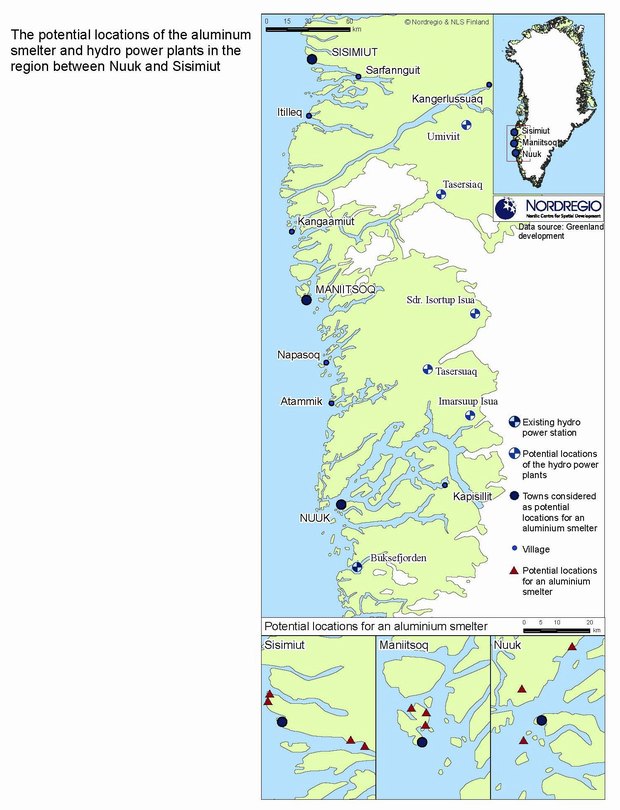Alcoa has received praise for its high standards in terms of social and environmental corporate responsibility. Good intentions alone are however no guarantee of success. Greenland's government will ultimately be responsible for the potentially wide-ranging economic, social and territorial effects of an aluminium smelter on its territory. The question is then whether it has the capacity to ensure that the smelter becomes an asset for Greenland as a whole.
Greenland is in the unique position of having vast hydro-electric potential which far exceeds the energy consump-tion of its 56,000 inhabitants. This energy potential is not however currently exploited. Greenland's 75 towns, villages and settlements are spread along the coast, without any roads or electric cables between them. The inhabitants thus predominantly rely on fossil fuel energy.
In an attempt to reap the benefits of their energy potential and with a desire to improve Greenland's prospects of becoming economically self-sufficient Greenland's government and Alcoa have recently discussed the possibility of establishing an aluminium smelter.
The initial impetus the project arose from the prospect of significantly improving state finances while also creating 400 new ´direct' jobs. The government emphasizes that Alcoa has promised to employ only Greenlanders at the smelter. It is however unclear where these employees will come from. According to Greenland's employer organisation, Greenland currently lacks some 1000 trained employees. Governmental plans to reclassify fishermen and hunters with insufficient income levels as workers in the mining or in the aluminium industries have furthermore been vigorously rejected by their union (KNAPK). More obviously than in other countries, Greenland's politics demonstrates that the selection of an industrial development strategy is also a major societal choice.
Another key issue here is the selection of a location for the smelter. Among the towns that have been considered, one finds Nuuk, the capital, with 14,700 inhabitants and Sisimiut, which is second largest with 5,344 inhabitants and often characterised as a being particularly entrepreneurial. The third option, Maniitsoq, which is the 6th largest settlement with 2,842 inhabitants, was however the one chosen by the government in a recommendation to Parliament dated February 21st, 2008. This decision followed a year-long process, in which the concerned municipalities have been involved.
The Government's recommendation is based on a series of arguments. The prime ones build on claims that the Maniitsoq plant has the most favourable strategic environmental assessment and the lowest building cost estimates. But the decision is also presented as the best choice in terms of regional development. The notion of polycentric development has even been mentioned in the debates. A smelter in Maniitsoq would contribute to the development of distinct activity profiles in the three towns. It would leave Nuuk with its role as the administrative capital, while Sisimiut could continue to be a centre for entrepreneurship and education. This would leave Maniitsoq to concentrate Greenland's competencies in the mining and energy sectors. This share of roles would, according to the Government, contribute to a more balanced approach to regional development.
The very use of the notion "regional development" in a country with no possibility of commuting between its settlements can however be challenged. Central regional policy notions such as "diffusing effects", "synergies" or "complementarities" simply do not apply. Spatial proximity is generally less relevant than Air Greenland schedules and fares when assessing the potential for interaction between two places. Very few towns can actually be characterised as "labour markets", i.e. as places where the offer of, and demand for, labour effectively regulates economic activity. As in many other Nordic peripheries, the market mechanisms which planning otherwise takes for granted operate only to a limited extent here.
As such, there is a strong case for further exchanges between Greenland and the other Nordic peripheries on issues of spatial development. Greenland's chal-lenges could help the rest of Norden gain a clearer understanding of its own regional specificities. As extreme cases of demographic sparsity and peripherality, Greenland's towns demonstrate the need for tailor-made policies in the northern peripheries. Their small population numbers and isolation may also give an indication of the type of challenges other Nordic peripheries may run into if the depopulating trends of recent decades are allowed to continue.
Inversely, the experience of other Nordic countries in terms of planning and foresight could usefully feed into Greenland's debates and strategies. Greenland could also usefully draw inspiration from other Nordic peripheries' attempts to develop a more holistic approach to the consideration of their aspirations and future needs, formulating overarching objectives and designing strategies to help achieve them.
The debates surrounding the aluminium smelter indeed demonstrate a lack of vision for Greenland. The communi-cative dimension of "planning", as a process bringing together stakeholders and actors to create a common under-standing of critical issues and a consensus around potential solutions has neither penetrated the administration nor, indeed, policy-making circles. With the aluminium smelter, Greenland is facing dramatic challenges and changes. However, the tools needed to manage them wisely, with a long term perspective and a broad consensus, are simply not yet in place.
The author wishes to thank Freia Lund Sørensen and Peter Barfoed for their help in providing information for this article. The views expressed herein are however the author's own.

By Erik Gløersen, previous Senior Research Fellow at Nordregio